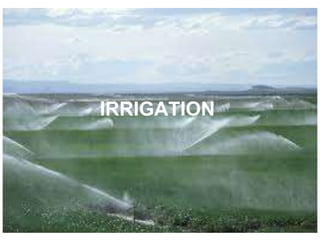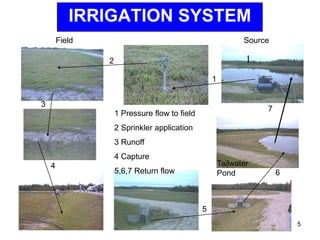Irrigation.ppt
- 1. IRRIGATION 1
- 2. IRRIGATION Irrigation is the artificial application of water to the land or soil. DRAINAGE Irrigation is often studied together with drainage, which is the natural or artificial removal of surface and sub-surface water from a given area. 2
- 3. USES OF IRRIGATION Growing of agricultural crops Maintenance of landscapes Re-vegetation of disturbed soils in dry areas and during periods of inadequate rainfall Protecting plants against frost Suppressing weed growing in grain fields Preventing soil consolidation Dust suppression Disposal of sewage Mining 3
- 4. IRRIGATION SYSTEM An irrigation system is more than application method It includes; Source of water Management of water Conveyance of water Application of water Capture and reuse (Tail water Recovery) 4
- 5. 1 1 2 3 4 5 6 7 1 Pressure flow to field 2 Sprinkler application 3 Runoff 4 Capture 5,6,7 Return flow Field Source Tailwater Pond IRRIGATION SYSTEM 5
- 6. IRRIGATION SYSTEM Surface Irrigation Subsurface Irrigation Sprinkler Irrigation Micro Irrigation 6
- 7. Water applied by gravity flow Basin Irrigation – Entire field is flooded Furrow Irrigation – Water fed into small channels Border Irrigation – Strips of land divided by low dikes are flooded sequentially SURFACE IRRIGATION 7
- 8. BASIN IRRIGATION Basins are flat areas of land, surrounded by low levees or berms. The levees prevent the water from flowing to the adjacent fields. Basin irrigation is commonly used for rice grown on flat lands or in terraces on hillsides . 8
- 9. FURROW IRRIGATION Furrows are small, parallel channels, made to carry water in order to irrigate the crop. The crop is usually grown on the ridges between the furrows 9
- 10. BORDER IRRIGATION Borders are usually long, uniformly graded strips of land, separated by earth bunds. In Contrast to basin irrigation these bunds are not to contain the water for ponding but to guide it as it flows down the field 10
- 11. Rice (grows best when its roots are submerged) Pastures, e.g. alfalfa, clover Trees, e.g. citrus, bananas Broadcasted crops, e.g., cereals (Basin and Border Irrigation) Row crops (Furrow Irrigation) Not suited to crops which cannot stand in wet or waterlogged conditions for periods longer than 24 hours (root and tuber crops), e.g., potatoes, beets and carrots SUITABLE CROPS 11
- 12. It is the simplest of all irrigation systems Low initial cost Low energy costs if gravity can be used to supply the water Works well in odd shaped fields ADVANTAGES OF SURFACE IRRIGATION 12
- 13. High maintenance requirements Inefficient in water use Nutrients and pesticides are lost by deep percolation below the root zone Not suitable for crops which grow below ground such as potatoes, peanuts, sugar beets and carrots. DISADVANTAGES OF SURFACE IRRIGATION 13
- 14. Irrigation water is applied below the ground surface, thus raising the water table to the crop root zone Most crops are well suited for subsurface irrigation except very deep rooted crops such as alfalfa and cotton. SUBSURFACE IRRIGATION 14
- 15. Works best on flat fields SUBSURFACE IRRIGATION 15
- 16. Permits storage of water in the lower soil profile Reduces pumping costs Can be incorporated into an existing drainage system with low additional cost Captures plant nutrients at or near the water table for future use by plants ADVANTAGES OF SUBSURFACE IRRIGATION 16
- 17. Labor intensive to adjust elevation of weirs to change from drainage mode to irrigation mode and back again after heavy rains System cost can be high in soils with low hydraulic conductivity or rolling topography Water quality must be high DISADVANTAGES OF SUBSURFACE IRRIGATION 17
- 18. SPRINKLER IRRIGATION Water is applied similarly to natural rainfall Pumps supply water under pressure Water is distributed through a system of pipes to sprinkler heads Water breaks up into small water drops which fall to the ground Suitable crops include row crops, field crops, tree crops etc. 18
- 19. Frequent, low volume, low pressure application of water Drip Irrigation Suitable crops include orchards, windbreaks, vegetables etc. MICRO IRRIGATION 19
- 20. The most efficient irrigation method Little runoff and evaporation occur Deep percolation is easily controlled Systems are easily automated to reduce labor costs Much of the surface remains dry, reducing weeds Low tension water availability enhances growth, improves yield and quality ADVANTAGES OF MICRO IRRIGATION 20
- 21. Expensive to install and maintain A high level of management is required Clogging is a major problem Animals, especially rodents can damage plastic pipe less than 4″ diameter Elevation differences can cause poor distribution uniformity unless pressure regulators are used DISADVANTAGES OF MICRO IRRIGATION 21




















